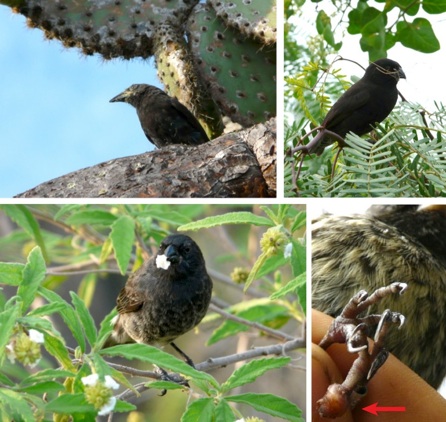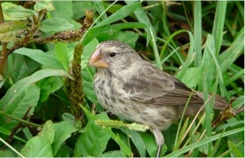By Julie Charbonnier, Department of Biology, Virginia Commonwealth University
Darwin was captivated by the Galápagos finches, whose great variation would lead him to question and challenge creationism. Darwin speculated that the different finches had descended from a common ancestor and had evolved to exploit new habitats. Inspired by these same species, Dr. Maxine Zylberberg traveled to the Galápagos in the Pacific Ocean to conduct her PhD research on the same birds, but for a different reason. The Galápagos offered a unique system to explore how differences in behavior, habitat and physiology interact to shape disease ecology.

Avian pox is a virus implicated in bird declines worldwide. “In Hawaii, a number of bird species have gone extinct due to avian pox and avian malaria.” explains Dr. Zylberberg. Avian pox was likely introduced to the Galápagos by human livestock in the 1890s. The avian pox system in the Galápagos offered an ideal study system for Dr. Zylberberg because there was known variation in avian pox prevalence and immune function among bird species. Additionally, individual species may live in different habitats, allowing Dr. Zylberberg to examine how different environments may impact the incidence of disease and immune function.
Dr. Zylberberg collected data from as many birds as possible: seven different species of finches, mockingbirds, and yellow warblers. From each bird, her team drew blood samples and recorded whether or not the bird was infected with avian pox. She used previous data from 2000-2004, and combined it with data she collected in 2008- 2009 to determine how prevalence of the disease was changing through time. In the lab, Dr. Zylberberg was able to estimate the birds’ ability to fight disease using immunological tests that measure the level of proteins that play important roles in the immune system: complement proteins, natural antibodies, PIT54 acute phase protein, and the heterophil:lymphocyte ratio.
She found that overall avian pox infections have increased dramatically in the past few years in the Galápagos, but that the magnitude of this increase varies both by species and geographical location. For example, small ground finches and small tree finches have experienced increased rates of infection, and fewer of them are recovering from the infection leading to higher mortality rates than a decade ago. The increase in prevalence of the disease in these species is correlated with interspecific variation in immune function, with species experiencing higher mortality exhibiting lower levels of immune function. Thus, the birds’ variation in immune function can partly explain their different vulnerabilities to the disease. Her results also suggest that avian pox outbreaks have increased in populations of birds near agriculture areas, though the reason behind this increase is unclear.
Working in this unique island system, Dr. Zylberberg faced challenges: “The most difficult part was logistics. In doing this project, I diverged from my advisor’s work and study system, so I needed to deal with all the logistics of setting up a new project in a new field site.” At one of her sites, a giant tortoise knocked down a net and bent one of her mist net pole. Despite the challenges, Dr. Zylberberg thinks the research “was definitely worth it”.

Determining why some species are better disease fighters, and why disease prevalence increases near agricultural areas, are the next important questions Dr. Zylberberg hopes to answer. These questions may be critical in preserving the integrity of the Galápagos bird community. For example, if she was able to identify specific agricultural chemicals that are suppressing immune function in the birds, then specific conservation steps could be implemented.
The avian fauna of the Galápagos continues to be a source of inspiration for evolutionary biologists and ecologists. Dr. Zylberberg’s research will help understand how avian pox is impacting this fauna, and how to best mitigate these effects and protect this unique part of the world.

Julie Charbonnier received her BA from the University of Pennsylvania, and is currently working on her Master’s degree at Virginia Commonwealth University. She is interested in how phenotypic plasticity influences amphibian populations across multiple life stages.

